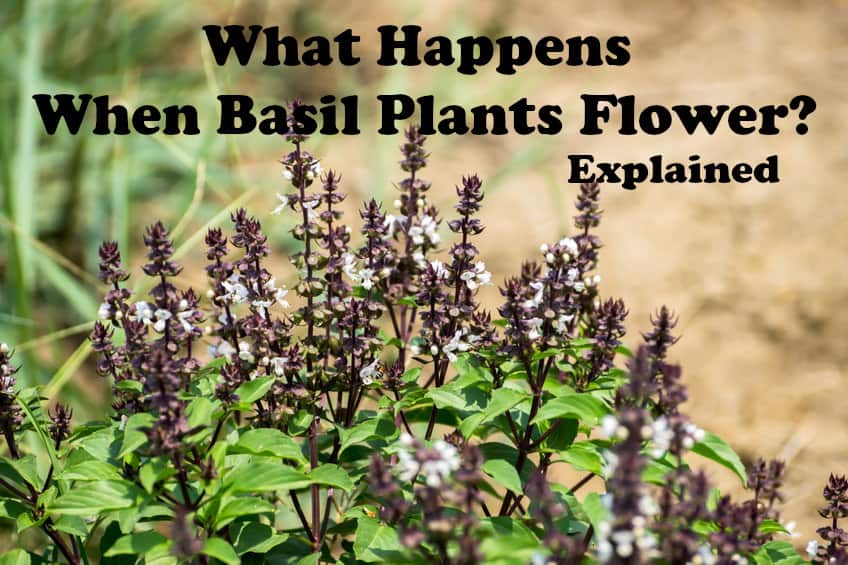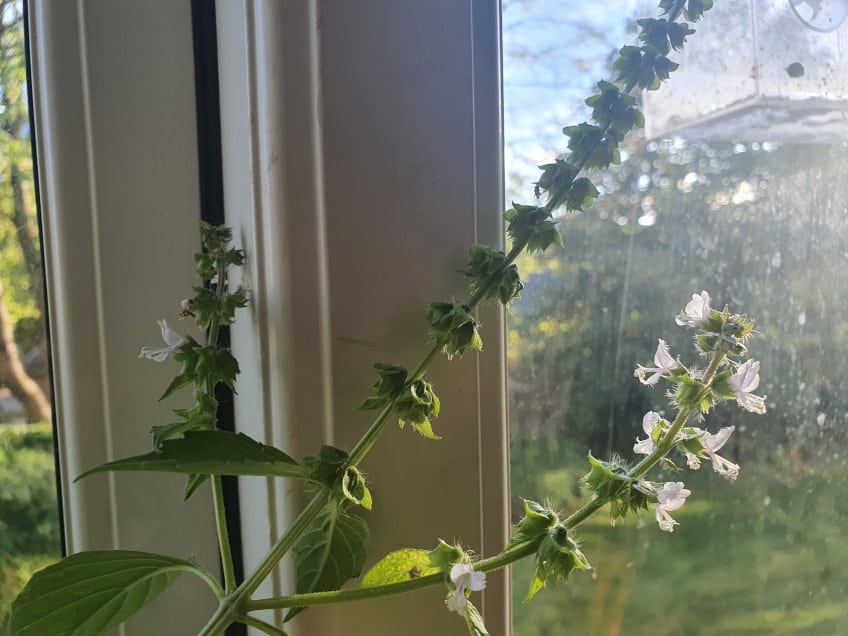Basil plants produce beautiful white or purple flowers when they have been growing for some time, but what actually happens when basil plants flower?
Flowering marks the transition from the growing stage to the reproduction stage for basil plants. Flower buds and seed pods begin to appear, and you will see stunted growth and leaf production as the energy is diverted towards flowering and seed production.
These are the most significant changes that happen to basil plants when they flower, but there are a few more things to know about. In this article, I will help you understand precisely what to expect when basil plants flower and what you should do so you are prepared when it happens. After growing basil for many years, I have a pretty good idea of what happens, but I also called a local garden center and asked one of their gardeners for input to make sure I didn’t miss anything important.

What to Expect When Basil Is Flowering (And Why It Happens)
Basil plants flower when they are nearing the end of their natural lifecycle, so on one hand, it means you probably won’t have your plants for much longer, but on the other hand, it means that you have done a good job caring for them.
When basil plants flower, you will notice some changes in how they look, behave, and even taste. I have found five things in particular that are good to know about.
Flower buds and seed pods appear
The first thing you will notice when your basil plants flower is the flower buds and seed pods that begin to appear at the tip of some of the stems.
As time passes, they will grow longer and have more and more seed pods to be able to produce as many seeds as possible. After some time, seeds will begin to appear inside the seed pods, and the flowers will start to dry and disappear. At this point, you can harvest the seeds and use them to grow more basil for free. I have another article where I explain how to do that.
Stunted growth
Part of what happens when basil plants flower is that they divert their use of energy from growing and producing leaves to producing flowers and seeds.
As a result of that, the plant will begin to grow slower and slower and eventually stop altogether when it is flowering, and if you harvest some of the leaves or stems, they will not grow back anywhere near as fast and vigorously as before it was flowering.
If you are fast enough and remove the flowers as fast as they appear, the energy will go back towards growing and producing leaves, but if the plant has been flowering for too long, it has most likely left the growing and production stage for good and will just continue to produce new flowers.
While stunted growth is expected for flowering basil plants, you should know that it is a sign of something being wrong if it happens without the plant being in the flowering stage. You can read more about why basil plants stop growing and what to do about it on this link.
Stems begin to turn brown and woody
As basil plants mature, their stems begin to get woody and brown instead of being flexible and light green. The stems first start to turn woody near the bottom, and then it will move upwards. This is a completely natural and expected thing that provides some protection from the plant.
Leaves become bitter
When basil plants flower, the leaves usually become more and more bitter. You probably won’t really notice it early in the flowering process, but later on, the leaves don’t taste good at all.
You can still eat the leaves, but I recommend being a bit extra cautious when the plant is flowering because of the change in taste. So take one or a few leaves and taste them before you harvest more to see if they taste fine.
The plants die
The whole purpose of flowering is reproduction, and once the plants have finished producing seeds, they have served their purpose and will begin to dry out and die.
The only exception to this is for perennial basil varieties such as Thai basil and African blue basil, as they can live for multiple years if they are not exposed to frost, however, most basil varieties are annuals that only live for one year, so once they are done producing seeds, they are done living.
What to Do When Basil Plants Are Flowering

You essentially have two options when basil is flowering; to do nothing and let the plants flower or remove the flowers as soon as they appear.
If you want to keep your plant growing and producing leaves, do this:
Remove basil flowers as soon as they appear to keep the plant growing and producing leaves. Either pinch them off with two fingers or use clean, sharp pruning shears to cut the stem just underneath the flower. Other than delaying flowering, this also makes the plant bushier.
If you want to collect seeds and attract bees and other pollinators to your garden, do this:
Allow basil plants to flower and go through the entire process of producing seeds. Once the flowers are completely dry, the seeds are ready for collection, and until then, the flowers attract bees and other pollinators, which are great for your garden.
I have another post (here) where I go into a lot more detail with the topic of when you should and shouldn’t remove the flowers for your basil plants, so if you are not sure, I recommend heading over to that post.
Read My Complete Guide to Growing and Caring for Basil
I have written a thorough guide where I cover all parts of growing your own basil including choosing a variety, sowing the seeds, the best growing conditions, pruning, propagation, harvesting, storing, solving various problems, and a lot more. You can find the article on this link.

